
Federal Reserve policymakers expressed significant reluctance to lower interest rates again in December, according to meeting minutes released Wednesday, setting up a potential confrontation with President Donald Trump who has demanded the central bank ease monetary policy.
The minutes from the Fed's October 28-29 meeting revealed deep divisions among officials about the path forward, with "many participants" suggesting rates should remain unchanged for the rest of the year despite ongoing economic uncertainties stemming from tariff policies and uneven labor market conditions.
"Many participants suggested that, under their economic outlooks, it would likely be appropriate to keep the target range unchanged for the rest of the year," the minutes stated.

The cautious stance is certain to escalate tensions with Trump, who said Wednesday he would "love to fire" Fed Chair Jerome Powell and urged Treasury Secretary Scott Bessent to "work on" the central bank chief. Trump has consistently pushed for lower interest rates to stimulate economic growth.
At the October meeting, Fed officials voted to reduce the benchmark lending rate by 25 basis points to a range of 3.75-4.0 percent, marking the second consecutive rate cut this year. However, Powell indicated shortly after that decision that a December reduction was "not a foregone conclusion."
According to the newly released minutes, "participants expressed strongly differing views about what policy decision would most likely be appropriate" for December. While most officials agreed that further cuts would likely be warranted over time, several indicated they did not view another quarter-point reduction as the best option for the upcoming meeting.
The Fed's deliberations have been complicated by a data blackout caused by a record-long government shutdown that ran from October to mid-November, suspending the release of key economic reports including inflation data. Officials acknowledged the need to be "deliberate in its policy decisions," partly due to the limited availability of current economic indicators.
"These minutes underline that the FOMC (Federal Open Market Committee) remains far more divided than usual on the next steps," said Oliver Allen of Pantheon Macroeconomics, though he expects continued policy easing over time.
Many Fed officials anticipate an uptick in underlying goods inflation in coming quarters as Trump's tariffs filter through the economy, though the timing and magnitude remain uncertain as businesses adjust their pricing strategies.
On employment, officials generally expect labor market conditions to "soften gradually" in the months ahead, with firms showing reluctance to either hire new workers or implement layoffs.
The minutes also highlighted growing economic inequality, with officials noting "a divergence in spending patterns across income groups." Consumption growth appears disproportionately driven by higher-income households benefiting from strong equity markets, while lower-income households have become increasingly price-sensitive and are adjusting spending in response to elevated costs and economic uncertainty.
The October vote breakdown showed 10 of 12 voting FOMC members supporting the quarter-point rate cut. Fed Governor Stephen Miran dissented in favor of a larger 50 basis point reduction, while Kansas City Fed President Jeffrey Schmid preferred keeping rates unchanged.